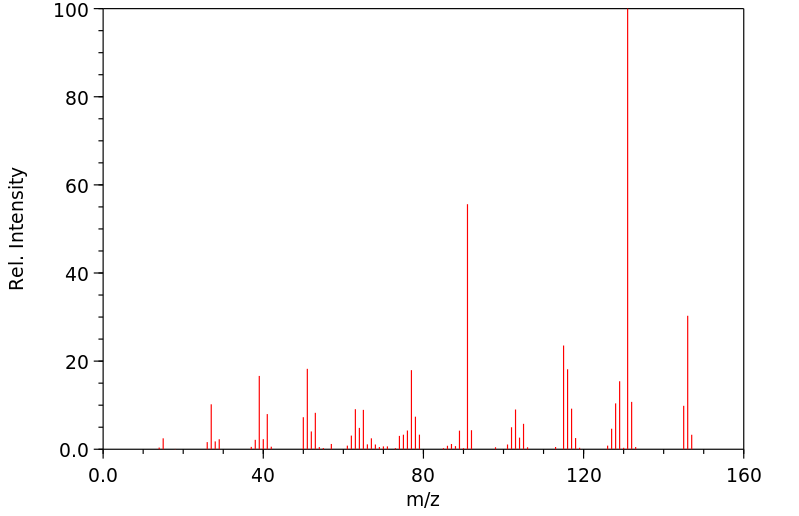(E/Z)-2-phenylpent-2-ene | 53172-84-2
中文名称
——
中文别名
——
英文名称
(E/Z)-2-phenylpent-2-ene
英文别名
2-phenyl-2-pentene;(1-methyl-1-butenyl)benzene;pent-2-en-2-ylbenzene
CAS
53172-84-2
化学式
C11H14
mdl
——
分子量
146.232
InChiKey
PLPHXVSTHYOUJO-UHFFFAOYSA-N
BEILSTEIN
——
EINECS
——
-
物化性质
-
计算性质
-
ADMET
-
安全信息
-
SDS
-
制备方法与用途
-
上下游信息
-
文献信息
-
表征谱图
-
同类化合物
-
相关功能分类
-
相关结构分类
物化性质
-
熔点:-37°C (estimate)
-
沸点:200.87°C (estimate)
-
密度:0.8950
计算性质
-
辛醇/水分配系数(LogP):4
-
重原子数:11
-
可旋转键数:2
-
环数:1.0
-
sp3杂化的碳原子比例:0.272
-
拓扑面积:0
-
氢给体数:0
-
氢受体数:0
SDS
上下游信息
反应信息
-
作为反应物:描述:(E/Z)-2-phenylpent-2-ene 在 cobalt 作用下, 以 四氢呋喃 为溶剂, 20.0 ℃ 、200.0 kPa 条件下, 以69%的产率得到2-苯基戊烷参考文献:名称:用于氢化的可回收钴(0)纳米颗粒催化剂†摘要:寻找替代贵金属的新型加氢催化剂的主要原因是对可持续性的关注以及3d过渡金属的独特机械特性。据报道,在还原剂存在下或在高温条件下,钴前体和特定配体的几种组合可提供活性加氢催化剂。这项研究报告了一种在不存在配体或表面活性剂的情况下通过还原商业CoCl 2制备小的单分散Co(0)纳米颗粒(3-4 nm)的新方法。在烯烃,炔烃,亚胺和杂芳烃(2–20 bar H 2)的氢化中观察到高催化活性。磁性使催化剂分离和多次回收成为可能。DOI:10.1039/c8cy00595h
-
作为产物:描述:参考文献:名称:Fischer, Peter M.; Howden, Merlin E. H., Journal of the Chemical Society. Perkin transactions I, 1987, p. 475 - 480摘要:DOI:
文献信息
-
Oxidative rearrangements of arylalkenes with [hydroxy(tosyloxy)iodo]benzene in 95% methanol: a general, regiospecific synthesis of α-aryl ketones作者:Michael W. Justik、Gerald F. KoserDOI:10.1016/j.tetlet.2004.06.029日期:2004.8The treatment of arylalkenes with [hydroxy(tosyloxy)iodo]benzene in 95% methanol affords the corresponding α-aryl ketones. This oxidative rearrangement is general for acyclic and cyclic arylalkenes and permits regioselective syntheses of isomeric α-phenyl ketone pairs.
-
Reductive Activation and Hydrofunctionalization of Olefins by Multiphoton Tandem Photoredox Catalysis作者:Milena L. Czyz、Mitchell S. Taylor、Tyra H. Horngren、Anastasios PolyzosDOI:10.1021/acscatal.1c01000日期:2021.5.7of olefin feedstocks to architecturally complex alkanes represents an important strategy in the expedient generation of valuable molecules for the chemical and life sciences. Synthetic approaches are reliant on the electrophilic activation of unactivated olefins, necessitating functionalization with nucleophiles. However, the reductive functionalization of unactivated and less activated olefins with烯烃原料向结构复杂的烷烃的转化代表了重要的策略,可快速生成化学和生命科学领域有价值的分子。合成方法依赖于未活化烯烃的亲电子活化,因此必须用亲核试剂进行官能化。然而,用亲电子试剂将未活化的和活化程度较低的烯烃还原功能化仍然是合成化学中的一个持续挑战。在这里,我们报告通过光诱导直接单电子还原为相应的亲核自由基阴离子的惰性苯乙烯的亲核活化。该方法的核心是铱光催化剂[Ir(ppy)2(dtb-bpy)] PF 6的多光子串联光氧化还原循环,该循环触发原位形成高能光还原剂,该光还原剂可选择性地将苯乙烯烯烃π键还原为自由基阴离子,而无需化学计量的还原剂或溶解金属。这种温和的策略可以实现苯乙烯的化学选择性还原和加氢官能化,从而提供有价值的烷烃和叔醇衍生物。机理研究支持苯乙烯烯烃自由基阴离子中间体的形成和涉及两个连续单电子转移的Birch型还原。总体而言,这种烯烃活化的互补方式可实现低亲和度的烯烃与亲电试
-
Photochemical reactivity of α-phenyl β,γ-enones. Singlet 1,3-acyl shift, triplet aromatic di-π-methane (DPM) rearrangement and triplet aryl-carbonyl bridging作者:Margareth J. C. M. Koppes、Peter C. J. Beentjes、Hans CerfontainDOI:10.1002/recl.19881070404日期:——The photochemistry of the series of α-phenyl β,γ-enones 6–10 has been studied under conditions of both direct (λ 300 nm) and triplet-sensitized irradiation with the aim of determining the reactivity patterns of these “multi”-chromophoric systems.在直接(λ300 nm)和三重态敏化辐射的条件下,研究了一系列α-苯基β,γ-烯酮6-10的光化学,目的是确定这些“多”发色团的反应模式系统。
-
Direct Synthesis of Enones by Visible-Light-Promoted Oxygenation of Trisubstituted Olefins Using Molecular Oxygen作者:Shinji Harada、Daiki Matsuda、Takahiro Morikawa、Atsushi NishidaDOI:10.1055/s-0040-1707150日期:2020.9enones from olefins is described. The reaction was performed under visible-light irradiation in the presence of molecular oxygen and a photocatalyst. The reaction proceeded with various types of trisubstituted olefins to give enones in good yields with high regioselectivity. In particular, oxygen- and nitrogen-containing functional groups, heteroaromatic rings, and cyclopropanes were tolerated. Mechanistic描述了从烯烃一步合成烯酮。在分子氧和光催化剂存在下,在可见光照射下进行反应。该反应与各种类型的三取代烯烃一起进行,以高产率和高区域选择性得到烯酮。特别是,含氧和含氮的官能团、杂芳环和环丙烷是可以容忍的。机理研究和先前的报告表明,反应体系中产生的活性氧是单线态氧。
-
Selective Condensation of [3-(Alkylthio)allyl]titanium Reagent with Carbonyl Compounds作者:Kyoji Furuta、Yoshihiko Ikeda、Noriyuki Meguriya、Nobuo Ikeda、Hisashi YamamotoDOI:10.1246/bcsj.57.2781日期:1984.10[3-(Ethylthio)allyl]titanium reagent generated easily from allyl ethyl sulfides condensed with aldehydes to give erythro-β-hydroxy sulfides in highly regio- and stereoselective manner. In contrast, crotyl ethyl sulfide reacted with aldehydes affording δ-hydroxy vinyl sulfide exclusively. The substitution pattern of the starting sulfide can have a pronounced effect on the selectivity in this condensation reaction
表征谱图
-
氢谱1HNMR
-
质谱MS
-
碳谱13CNMR
-
红外IR
-
拉曼Raman
-
峰位数据
-
峰位匹配
-
表征信息
同类化合物
(βS)-β-氨基-4-(4-羟基苯氧基)-3,5-二碘苯甲丙醇
(S,S)-邻甲苯基-DIPAMP
(S)-(-)-7'-〔4(S)-(苄基)恶唑-2-基]-7-二(3,5-二-叔丁基苯基)膦基-2,2',3,3'-四氢-1,1-螺二氢茚
(S)-盐酸沙丁胺醇
(S)-3-(叔丁基)-4-(2,6-二甲氧基苯基)-2,3-二氢苯并[d][1,3]氧磷杂环戊二烯
(S)-2,2'-双[双(3,5-三氟甲基苯基)膦基]-4,4',6,6'-四甲氧基联苯
(S)-1-[3,5-双(三氟甲基)苯基]-3-[1-(二甲基氨基)-3-甲基丁烷-2-基]硫脲
(R)富马酸托特罗定
(R)-(-)-盐酸尼古地平
(R)-(-)-4,12-双(二苯基膦基)[2.2]对环芳烷(1,5环辛二烯)铑(I)四氟硼酸盐
(R)-(+)-7-双(3,5-二叔丁基苯基)膦基7''-[((6-甲基吡啶-2-基甲基)氨基]-2,2'',3,3''-四氢-1,1''-螺双茚满
(R)-(+)-7-双(3,5-二叔丁基苯基)膦基7''-[(4-叔丁基吡啶-2-基甲基)氨基]-2,2'',3,3''-四氢-1,1''-螺双茚满
(R)-(+)-7-双(3,5-二叔丁基苯基)膦基7''-[(3-甲基吡啶-2-基甲基)氨基]-2,2'',3,3''-四氢-1,1''-螺双茚满
(R)-(+)-4,7-双(3,5-二-叔丁基苯基)膦基-7“-[(吡啶-2-基甲基)氨基]-2,2”,3,3'-四氢1,1'-螺二茚满
(R)-3-(叔丁基)-4-(2,6-二苯氧基苯基)-2,3-二氢苯并[d][1,3]氧杂磷杂环戊烯
(R)-2-[((二苯基膦基)甲基]吡咯烷
(R)-1-[3,5-双(三氟甲基)苯基]-3-[1-(二甲基氨基)-3-甲基丁烷-2-基]硫脲
(N-(4-甲氧基苯基)-N-甲基-3-(1-哌啶基)丙-2-烯酰胺)
(5-溴-2-羟基苯基)-4-氯苯甲酮
(5-溴-2-氯苯基)(4-羟基苯基)甲酮
(5-氧代-3-苯基-2,5-二氢-1,2,3,4-oxatriazol-3-鎓)
(4S,5R)-4-甲基-5-苯基-1,2,3-氧代噻唑烷-2,2-二氧化物-3-羧酸叔丁酯
(4S,4''S)-2,2''-亚环戊基双[4,5-二氢-4-(苯甲基)恶唑]
(4-溴苯基)-[2-氟-4-[6-[甲基(丙-2-烯基)氨基]己氧基]苯基]甲酮
(4-丁氧基苯甲基)三苯基溴化磷
(3aR,8aR)-(-)-4,4,8,8-四(3,5-二甲基苯基)四氢-2,2-二甲基-6-苯基-1,3-二氧戊环[4,5-e]二恶唑磷
(3aR,6aS)-5-氧代六氢环戊基[c]吡咯-2(1H)-羧酸酯
(2Z)-3-[[(4-氯苯基)氨基]-2-氰基丙烯酸乙酯
(2S,3S,5S)-5-(叔丁氧基甲酰氨基)-2-(N-5-噻唑基-甲氧羰基)氨基-1,6-二苯基-3-羟基己烷
(2S,2''S,3S,3''S)-3,3''-二叔丁基-4,4''-双(2,6-二甲氧基苯基)-2,2'',3,3''-四氢-2,2''-联苯并[d][1,3]氧杂磷杂戊环
(2S)-(-)-2-{[[[[3,5-双(氟代甲基)苯基]氨基]硫代甲基]氨基}-N-(二苯基甲基)-N,3,3-三甲基丁酰胺
(2S)-2-[[[[[((1S,2S)-2-氨基环己基]氨基]硫代甲基]氨基]-N-(二苯甲基)-N,3,3-三甲基丁酰胺
(2S)-2-[[[[[[((1R,2R)-2-氨基环己基]氨基]硫代甲基]氨基]-N-(二苯甲基)-N,3,3-三甲基丁酰胺
(2-硝基苯基)磷酸三酰胺
(2,6-二氯苯基)乙酰氯
(2,3-二甲氧基-5-甲基苯基)硼酸
(1S,2S,3S,5S)-5-叠氮基-3-(苯基甲氧基)-2-[(苯基甲氧基)甲基]环戊醇
(1S,2S,3R,5R)-2-(苄氧基)甲基-6-氧杂双环[3.1.0]己-3-醇
(1-(4-氟苯基)环丙基)甲胺盐酸盐
(1-(3-溴苯基)环丁基)甲胺盐酸盐
(1-(2-氯苯基)环丁基)甲胺盐酸盐
(1-(2-氟苯基)环丙基)甲胺盐酸盐
(1-(2,6-二氟苯基)环丙基)甲胺盐酸盐
(-)-去甲基西布曲明
龙蒿油
龙胆酸钠
龙胆酸叔丁酯
龙胆酸
龙胆紫-d6
龙胆紫







